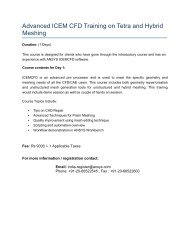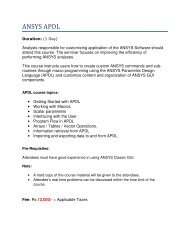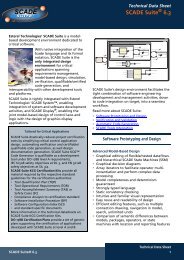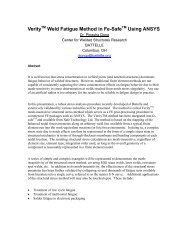Simulation - ANSYS
Simulation - ANSYS
Simulation - ANSYS
You also want an ePaper? Increase the reach of your titles
YUMPU automatically turns print PDFs into web optimized ePapers that Google loves.
PRODUCTS & TECHNOLOGY: DESIGN FOR SIX SIGMA<br />
Applying Six Sigma<br />
to Drive Down<br />
Product Defects<br />
Probabilistic design and sensitivity analyses help engineers<br />
quickly arrive at near-zero product failures in the face of<br />
wide manufacturing variabilities and other uncertainties.<br />
By Andreas Vlahinos, President, Advanced Engineering Solutions, Colorado, U.S.A.<br />
14<br />
Andreas Vlahinos<br />
<strong>ANSYS</strong> Advantage • Volume II, Issue 2, 2008<br />
Companies often are focused<br />
primarily on time-to-market, but the<br />
advantages of fast product introductions<br />
may be quickly overshadowed by<br />
the huge cost of poor quality, resulting<br />
in product recalls, rework, warranty<br />
payments and lost business from<br />
negative brand image.<br />
In many cases, such quality problems<br />
are the result of variations in<br />
factors such as customer usage,<br />
manufacturing, suppliers, distribution,<br />
delivery, installation or degradation<br />
over the life of the product. In general,<br />
such variations are not taken into consideration<br />
as part of the development<br />
of the product. Rather, the integrity and<br />
reliability of a design is typically based<br />
on an ideal set of assumptions that<br />
may be far removed from actual realworld<br />
circumstances. The result is a<br />
design that may be theoretically sound<br />
but riddled with defects once it is<br />
manufactured and in use.<br />
Design for Six Sigma (DFSS) is a<br />
statistical method for radically reducing<br />
these defects by developing designs<br />
that deliver a given target performance<br />
despite these variations. The approach<br />
is a measure of quality represented as<br />
the number of standard deviations<br />
away from a statistical mean of a target<br />
performance value. Operating at three<br />
sigma translates into about 67,000<br />
defects per million parts, performance<br />
typical of most manufacturers. A rating<br />
of six sigma equates to just 3.4 defects<br />
per million, or virtually zero defects.<br />
Achieving this level of quality<br />
requires a focused effort upfront in development,<br />
with design optimization driven<br />
by integration of DFSS into the process<br />
and rigorous use of simulation. In such<br />
DFSS efforts, <strong>ANSYS</strong> DesignXplorer<br />
software is a particularly valuable<br />
tool. Working from within the <strong>ANSYS</strong><br />
Workbench platform and in conjunction<br />
with <strong>ANSYS</strong> Mechanical and other<br />
<strong>ANSYS</strong> Mechanical parametric model of a gasket is automatically changed for each of the 10,000 DOE analyses performed.<br />
www.ansys.com
















